You may have noticed that I neglected to write an introductory paragraph for the last one of these — I was just too excited to get into the keyboards and keyboard accessories, I guess. I can’t promise that I’ll always have something to say up here, but this week I definitely do: thank you for all the tips I’ve received so far! The readers are what make Hackaday great, and this little keyboard roundup column is no exception. Fabulous fodder, folks!
Kamina Chameleon
![[deshipu]'s DIY keyboard with various center modules](https://hackaday.com/wp-content/uploads/2021/08/deʃhipu-Kamina.png?w=400)
The latest version is the Kamina, a one-piece split with a SAMD21 brain that is slim and narrow without being cramped. [deʃhipu] started by splitting the Planck layout, spreading it, adding a number row, and eventually, an extra column of Kailh Chocs on the right hand. One-piece splits are great as long as the split suits your shoulders, because everything stays in place. When you do move it around, both halves move as one and you don’t have to mess with the positioning nearly as much as with a two-piece. And of course, since he designed it himself, it fits.
The really cool thing here is the center module concept. It’s functional, it looks nice, and as long as it doesn’t get in the way of typing, seems ideal. So far, [deʃhipu] has made a couple different versions with joysticks, encoders, and buttons, and is currently working on one with a Home button made for cell phones to take advantage of their built-in optical trackpads.
Esrille NISSE Looks Nice
This is the Esrille NISSE keyboard and it comes in two sizes! Okay, the two sizes don’t look that different, but the key spacing specs say otherwise. To me, this looks like an Alice with a better and ortholinear layout. These bat-wing beauties are new to me, but they’ve been around for a few years now and are probably difficult to stumble upon outside of Japan. Although Esrille doesn’t seem to make any other keyboards, they do make a portable PC built on the Raspberry Pi compute module.
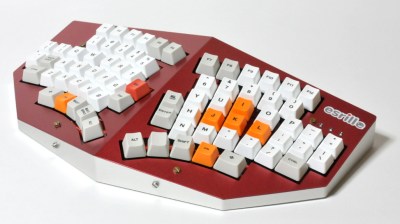
I love me a one-piece split when its done properly, and this one seems to be pretty darn close to perfect. How do I know? You can print out a paper-craft version to try out either of the two sizes. I didn’t take it quite that far, but you can bet that I opened the smaller size’s image in a new tab and put my hands all over the screen to test the layout.
I especially like the thumb clusters and the inside keys on this thing, but I think the innermost thumb keys would be too painful to use, and I would probably just use my index finger. I would totally buy one of these, but they’re a little too expensive, especially since the smaller one costs more. (What’s up with that?) The great news is that the firmware is open-source. Between that and the paper-craft models, a person could probably build their own. Check out [xahlee]’s site for a review and a lot more pictures of the NISSE and similar keebs.
Check This Out: Making Double Shot Polyurethane Keycaps
There’s more than one way to put legends on keycaps, and the double shot method is definitely the longest-lasting. Double shot keycaps are kind of what they sound like — they’re made in two pieces; one for the legend, and one for the rest of the keycap. Double shot keycaps are awesome because you can’t feel the legends and it’s impossible for them to wear off. They are forever, and making them requires an intricate process.
This dramatic video that’s set to Ride of the Valkyries doesn’t offer much in the way of explanation, but you will see every single step of this three-day process go by in what feels like more than five minutes. It starts out with a mold made of LEGO, so you might think this is something you can easily pull off in a weekend, but it gets complicated pretty quickly.
Big thanks to both [Inne Lemstra] and [Zane Atkins] for tipping about this one. The system works!
New Hotness: Adafruit’s RP 2040 Macropad
I got my Adafruit ADA BOX this week and (spoiler alert!) it features their Raspberry Pi RP2040-based macropad. The idea here is that you can scroll through and select different macro group profiles with the rotary encoder giving you nearly limitless bindings in a small package. You can use RGB to tell your menus apart, and you get enough space on the OLED to show a short label for each of the 12 keys that appear in a matching matrix.
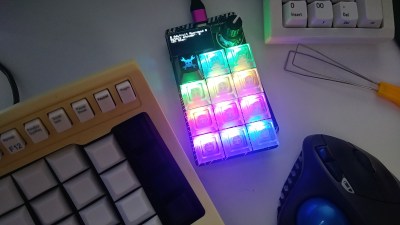
Adafruit sent these out with Kailh reds (linear switches), which are totally not my jam, but I know linears are popular, and I suppose it’s better to err on the side of silence rather than clack a bunch of people into annoyance. I used a dozen Cherry MX clears at first, but those have all-black enclosures and don’t let the RGB through as well (though I think they look pretty cool anyway). Pictured here are Kailh box whites, which have clear upper housings, and they’re topped with the included translucent DSA keycaps.
Yes, that’s a Jolly Wrencher in the upper left! I was quite fortunate to receive an extremely limited-edition Hackaday keycap that’s 16 years in the making (thanks pt!). If you missed our Python Your Keeb Hack Chat with the crew from Adafruit, go check it out and peep this video of double shot beauty of a keycap. I’m not yet sure what I’ll do with my macro pad. I’m leaning towards work-related shortcuts, or maybe creating some kind of game that requires cranking the rotary encoder and pushing the keys somehow.
Historical Clackers: Index Typewriters
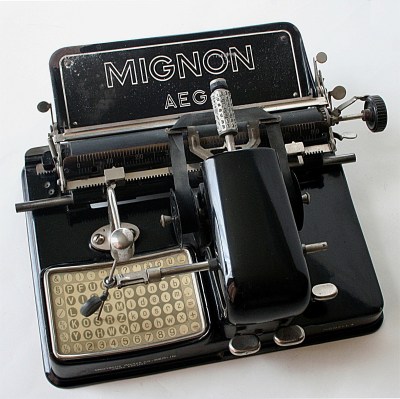
Index typewriters were invented in 1880 and fell out of fashion by the 1940s. They are called so for one of two reasons: either because it uses a pointer to choose from an index of characters, or because you use your index finger to work the pointer.
In either case, the pointer is mechanically linked to the corresponding type element that prints the character, and you just push a lever to type after making your selection. A second lever does the work of the space bar.
There were a few different styles of index typewriter over the years, and many of the designs are interesting. Compared with typewriters, they were all relatively small and lightweight, and cheaper to manufacture without the keyboard. As a result, index typewriters were mainly marketed to writers on the go.
The index typewriter is still around in the form of the handheld embossers that predate the electronic label makers of today. Many label makers and index typewriters are laid out alphabetically, and some had their own non-qwerty layouts.
In Case You Missed It
Have you ever heard of magnetic, Hall-effect key switches? You bet they’re the height of clacky. Well, [riskable] is bringing them back en vogue with a modern twist. These are magnetic separation switches in the sense that actuation forces two magnets apart, yes. But they’re also magnetic levitation switches — instead of a spring, there’s a third magnet in the keycap that helps it return to the home position.
What’s better than an IBM Model M? Not much if you ask us, but then we saw [Steve M. Potter] take all these lovely buckling spring switches and give them handmade wooden keycaps with Scrabble tile veneers. What a high-scoring build!
Got a hot tip that has like, anything to do with keyboards? Help me out by sending in a link or two. Don’t want all the Hackaday scribes to see it? Feel free to email me directly.

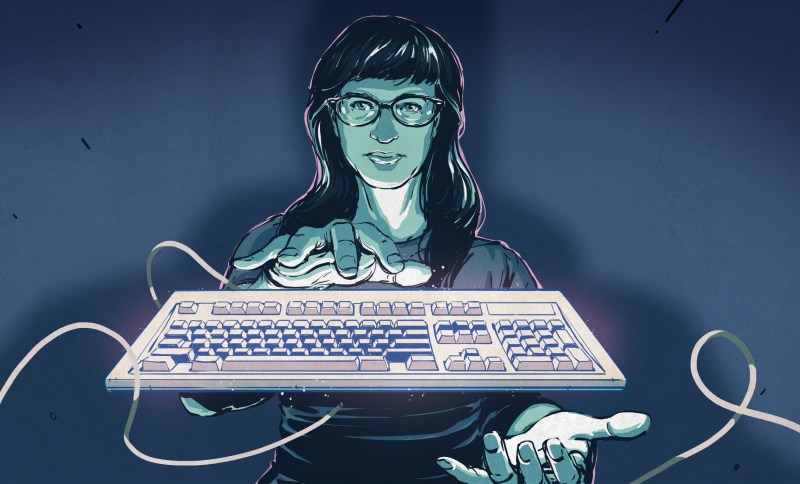
![[riskable]'s clacky magnetic switches](https://hackaday.com/wp-content/uploads/2021/07/mag-lev-void-keyswitches-800.jpg?w=250)
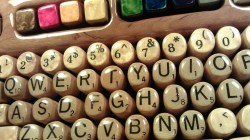













SLA 3D printer of course
I would very much want the one with an encoder under a thumb (although witth a different layout, admittedly). I have tried an encoder for left/right arrow keys and it is fantastic for editing.
A long time ago I was also interested in those “natural” keyboards, but never was willing to spend $$$ for them.
Only recently I realized that the “unnatural wrist angle” does not exist for me at all. My index finger and middle finger (and also ring finger) are (much) longer then my pinkies, and the compensate (enough) so that there is no need for me to distort my wrists in strange angles.
And I do use 6 fingers, two pinkies and a thumb for typing.
The only thing I’m struggling with are those on screen keyboards.
My desire is very simple. i would like the numeric keypad to have an offset “0” (zero) key like good adding machines and desktop calculators always had. With a lot of numeric entry, having to move one’s thumb under the hand to hit zero is a nuisance (and sometimes, a real pain).
Damn that double shot keycap production setup looked really well thought out and quite doable, wonder what the failure rate was really like, I’m getting better but still about half of all my molds need remedial work to function properly (though I am generally doing smaller fiddly details)…
I also really like the idea of the rotary encoder and such in the middle of a keyboard, though getting me off a model M (or the now teensy scancode to usb converted IBM mainframe 122 key), I think it would have to be cheap or really required ergonomically (personally I don’t think I’ll ever have a problem with the standard keyboard layout, seems rather comfortable to me).
To be honest I myself never thought those fancy layouts were of any use. I tried a few mechanical keyboards, but they all were horrible for me, because they had huge key travel and really bad angle for your wrists, being so insanely thick. My favorite keyboard was always Logitech UltraX, until the last one that I had fell apart, and then I was left without any reasonable keyboard.
And then I’ve heard about low-profile mechanical keyboards. But at the time you couldn’t buy them, because they were a novelty, you could only buy switches and make your own. 101 switches is a lot of money, so I made a small, 36-key keyboard first. I actually used someone else’s design. It was split and orthonormal, but I didn’t care because I mostly wanted to know how the switches feel.
And then I realized that I actually touch-type on that keyboard, using all five fingers and not moving my hands, whereas on a “normal” keyboard I use three fingers of each hand and move the hands a lot. That made me wonder, and quickly I realized why: normal keyboard is too large for me to reach to Esc or Enter without moving my hand, not to mention that pressing Enter at that angle with my pinky finger is simply not possible — it’s not strong enough. Those cute tiny keyboards might look weird, and may seem complex, but switching a layer by holding down a key is really much simpler and quicker than moving your hand to the other side of the keyboard.
I have pretty giant hands, so anything under the normal scale of keyboard is awkward for me, the key spacing and distances getting smaller just don’t work for me well. But that is an often overlooked point around ergonomics, people come in a collection of scales, and stuff designed for the generally more dainty Asian hands (like Nintendo controllers) are just not comfortable for those with larger hands more common with European heritage.
Personally I like having reasonable key travel – though its not the most important bit, to me the most important bit is that there is a good tactile bump at key activation (and only at activation), so you can feel positively when the key is pressed and are not having to smash your fingers to the deck to actually get it to register the way most rubber dome keyboards are…
I started on a manual Olympia typewriter in high school. A lot of people thought I was crazy “typewriters are for girls who are going to be secretaries”. Then it was noted how much faster I was with a keypunch in computer class. I don’t have giant hands, but anything with spacing different from the old Telex and IBM keyboards result in a lot of errors. My hands do not move significantly for the letters and numbers on a QWERTY keyboard, but they do move for function keys and the escape keys. The old typewriters were the same. Regular letter and number keys were in reach, but for those machines that had extra keys, the hands had to move. That is why keyboards used to have little bumps on the f and j keys – to help touch typists locate the home position.
It is not just me. A place where I worked in the mid 1980s had a room with several personal computers as part of a trial program. it was noted that one computer got little use, and was reported as a lot of keyboard errors. When the computers were moved to a different room, the keyboard on that computer was intentionally connected to a different computer. The error reports switched to the computer to which the keyboard was attached. More attention was paid to the actual errors. Then then all of the personal computer keyboards were measured, as well as the two standard keyboards used on mainframe terminals throughout the building. it was determined that that one keyboard had a smaller key spacing than any of the others, which were all the same. Eventually many more personal computers were purchased (cheaper than mainframe time), but none from the vendor with close keys keyboard!.
I make sure I get cell phones that will convert handwriting to text (or that will use software apps that do), as the keyboards are frequently to small for me to use without a stylus of some sort to “click” the buttons.
And, like Foldi-One, I prefer a keyboard with a definite resistance and stop that tells me when I have pressed a key. For those of us who grew up with moving keys & a tactile response, a touch screen keyboard does not work – too many extra letters & symbols by accident.
ESRILLE, why are you tilted toward me and not away from me? you had potential…
Hail to our keeb goddess and thank you for this awesome article.
I’ve really appreciated the double shot method even if I’m aware it is a real mess to produce something viable.
As a suggestion for your next articles I’d like to learn more about… custom keycaps or serigraphs….
Many of us with our fancy weird keyboards are looking for different methods for building custom serigraphs.
In my case I’m trying to serigraph transparent standard keycaps attached to Cherry MX keys.
I have a custom keyboard backlight and I’d like to use transparent keycaps with custom logo on them but without ruining touch or some sort of front painting. Do you have ideas ?
Index typewriters remained popular in Japan and China for longer than elsewhere! They were neither small nor lightweight, since they were meant to handle a couple thousand characters.